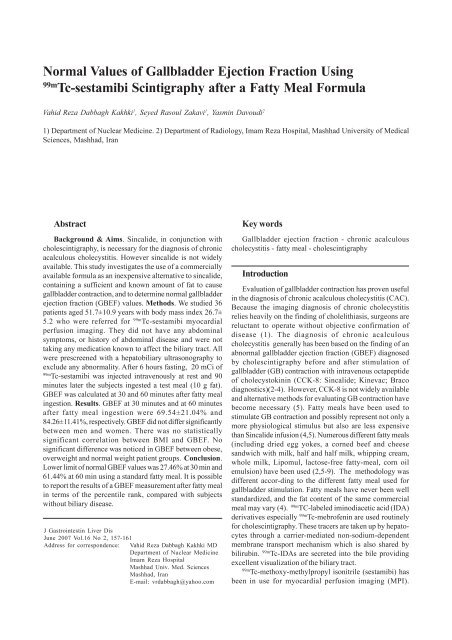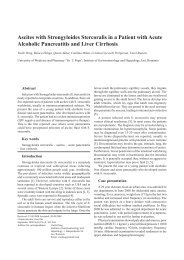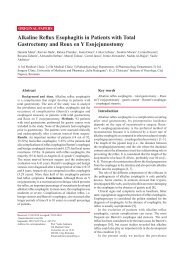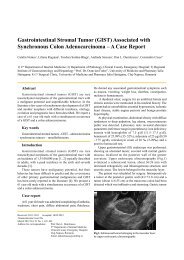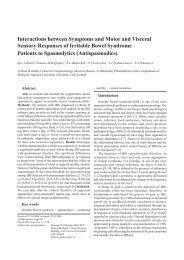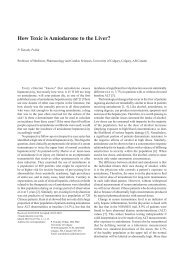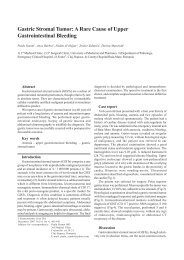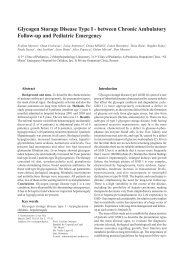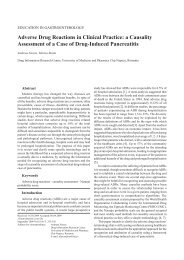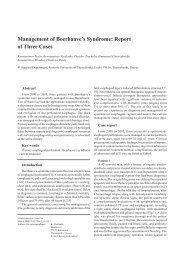Normal Values of Gallbladder Ejection Fraction Using ... - rjge.ro
Normal Values of Gallbladder Ejection Fraction Using ... - rjge.ro
Normal Values of Gallbladder Ejection Fraction Using ... - rjge.ro
You also want an ePaper? Increase the reach of your titles
YUMPU automatically turns print PDFs into web optimized ePapers that Google loves.
<st<strong>ro</strong>ng>Normal</st<strong>ro</strong>ng> gallbladder ejection fraction<br />
<st<strong>ro</strong>ng>Normal</st<strong>ro</strong>ng> <st<strong>ro</strong>ng>Values</st<strong>ro</strong>ng> <st<strong>ro</strong>ng>of</st<strong>ro</strong>ng> <st<strong>ro</strong>ng>Gallbladder</st<strong>ro</strong>ng> <st<strong>ro</strong>ng>Ejection</st<strong>ro</strong>ng> <st<strong>ro</strong>ng>Fraction</st<strong>ro</strong>ng> <st<strong>ro</strong>ng>Using</st<strong>ro</strong>ng><br />
99m<br />
Tc-sestamibi Scintigraphy after a Fatty Meal Formula<br />
Vahid Reza Dabbagh Kakhki 1 , Seyed Rasoul Zakavi 1 , Yasmin Davoudi 2<br />
1) Department <st<strong>ro</strong>ng>of</st<strong>ro</strong>ng> Nuclear Medicine. 2) Department <st<strong>ro</strong>ng>of</st<strong>ro</strong>ng> Radiology, Imam Reza Hospital, Mashhad University <st<strong>ro</strong>ng>of</st<strong>ro</strong>ng> Medical<br />
Sciences, Mashhad, Iran<br />
Abstract<br />
Backg<strong>ro</strong>und & Aims. Sincalide, in conjunction with<br />
cholescintigraphy, is necessary for the diagnosis <st<strong>ro</strong>ng>of</st<strong>ro</strong>ng> ch<strong>ro</strong>nic<br />
acalculous cholecystitis. However sincalide is not widely<br />
available. This study investigates the use <st<strong>ro</strong>ng>of</st<strong>ro</strong>ng> a commercially<br />
available formula as an inexpensive alternative to sincalide,<br />
containing a sufficient and known amount <st<strong>ro</strong>ng>of</st<strong>ro</strong>ng> fat to cause<br />
gallbladder contraction, and to determine normal gallbladder<br />
ejection fraction (GBEF) values. Methods. We studied 36<br />
patients aged 51.7±10.9 years with body mass index 26.7±<br />
5.2 who were referred for 99m Tc-sestamibi myocardial<br />
perfusion imaging. They did not have any abdominal<br />
symptoms, or history <st<strong>ro</strong>ng>of</st<strong>ro</strong>ng> abdominal disease and were not<br />
taking any medication known to affect the biliary tract. All<br />
were prescreened with a hepatobiliary ultrasonography to<br />
exclude any abnormality. After 6 hours fasting, 20 mCi <st<strong>ro</strong>ng>of</st<strong>ro</strong>ng><br />
99m<br />
Tc-sestamibi was injected intravenously at rest and 90<br />
minutes later the subjects ingested a test meal (10 g fat).<br />
GBEF was calculated at 30 and 60 minutes after fatty meal<br />
ingestion. Results. GBEF at 30 minutes and at 60 minutes<br />
after fatty meal ingestion were 69.54±21.04% and<br />
84.26±11.41%, respectively. GBEF did not differ significantly<br />
between men and women. There was no statistically<br />
significant correlation between BMI and GBEF. No<br />
significant difference was noticed in GBEF between obese,<br />
overweight and normal weight patient g<strong>ro</strong>ups. Conclusion.<br />
Lower limit <st<strong>ro</strong>ng>of</st<strong>ro</strong>ng> normal GBEF values was 27.46% at 30 min and<br />
61.44% at 60 min using a standard fatty meal. It is possible<br />
to report the results <st<strong>ro</strong>ng>of</st<strong>ro</strong>ng> a GBEF measurement after fatty meal<br />
in terms <st<strong>ro</strong>ng>of</st<strong>ro</strong>ng> the percentile rank, compared with subjects<br />
without biliary disease.<br />
J Gast<strong>ro</strong>intestin Liver Dis<br />
June 2007 Vol.16 No 2, 157-161<br />
Address for correspondence: Vahid Reza Dabbagh Kakhki MD<br />
Department <st<strong>ro</strong>ng>of</st<strong>ro</strong>ng> Nuclear Medicine<br />
Imam Reza Hospital<br />
Mashhad Univ. Med. Sciences<br />
Mashhad, Iran<br />
E-mail: vrdabbagh@yahoo.com<br />
Key words<br />
<st<strong>ro</strong>ng>Gallbladder</st<strong>ro</strong>ng> ejection fraction - ch<strong>ro</strong>nic acalculous<br />
cholecystitis - fatty meal - cholescintigraphy<br />
Int<strong>ro</strong>duction<br />
Evaluation <st<strong>ro</strong>ng>of</st<strong>ro</strong>ng> gallbladder contraction has p<strong>ro</strong>ven useful<br />
in the diagnosis <st<strong>ro</strong>ng>of</st<strong>ro</strong>ng> ch<strong>ro</strong>nic acalculous cholecystitis (CAC).<br />
Because the imaging diagnosis <st<strong>ro</strong>ng>of</st<strong>ro</strong>ng> ch<strong>ro</strong>nic cholecystitis<br />
relies heavily on the finding <st<strong>ro</strong>ng>of</st<strong>ro</strong>ng> cholelithiasis, surgeons are<br />
reluctant to operate without objective confirmation <st<strong>ro</strong>ng>of</st<strong>ro</strong>ng><br />
disease (1). The diagnosis <st<strong>ro</strong>ng>of</st<strong>ro</strong>ng> ch<strong>ro</strong>nic acalculous<br />
cholecystitis generally has been based on the finding <st<strong>ro</strong>ng>of</st<strong>ro</strong>ng> an<br />
abnormal gallbladder ejection fraction (GBEF) diagnosed<br />
by cholescintigraphy before and after stimulation <st<strong>ro</strong>ng>of</st<strong>ro</strong>ng><br />
gallbladder (GB) contraction with intravenous octapeptide<br />
<st<strong>ro</strong>ng>of</st<strong>ro</strong>ng> cholecystokinin (CCK-8: Sincalide; Kinevac; Braco<br />
diagnostics)(2-4). However, CCK-8 is not widely available<br />
and alternative methods for evaluating GB contraction have<br />
become necessary (5). Fatty meals have been used to<br />
stimulate GB contraction and possibly represent not only a<br />
more physiological stimulus but also are less expensive<br />
than Sincalide infusion (4,5). Nume<strong>ro</strong>us different fatty meals<br />
(including dried egg yokes, a corned beef and cheese<br />
sandwich with milk, half and half milk, whipping cream,<br />
whole milk, Lipomul, lactose-free fatty-meal, corn oil<br />
emulsion) have been used (2,5-9). The methodology was<br />
different accor-ding to the different fatty meal used for<br />
gallbladder stimulation. Fatty meals have never been well<br />
standardized, and the fat content <st<strong>ro</strong>ng>of</st<strong>ro</strong>ng> the same commercial<br />
meal may vary (4). 99m TC-labeled iminodiacetic acid (IDA)<br />
derivatives especially 99m Tc-mebr<st<strong>ro</strong>ng>of</st<strong>ro</strong>ng>enin are used <strong>ro</strong>utinely<br />
for cholescintigraphy. These tracers are taken up by hepatocytes<br />
th<strong>ro</strong>ugh a carrier-mediated non-sodium-dependent<br />
membrane transport mechanism which is also shared by<br />
bilirubin. 99m Tc-IDAs are secreted into the bile p<strong>ro</strong>viding<br />
excellent visualization <st<strong>ro</strong>ng>of</st<strong>ro</strong>ng> the biliary tract.<br />
99m<br />
Tc-methoxy-methylp<strong>ro</strong>pyl isonitrile (sestamibi) has<br />
been in use for myocardial perfusion imaging (MPI).
158<br />
<st<strong>ro</strong>ng>Normal</st<strong>ro</strong>ng>ly about 20% <st<strong>ro</strong>ng>of</st<strong>ro</strong>ng> the injected dose <st<strong>ro</strong>ng>of</st<strong>ro</strong>ng> 99m Tc-sestamibi<br />
is taken up by the liver and secreted into the bile. Thus the<br />
gallbladder is well visualized after injection <st<strong>ro</strong>ng>of</st<strong>ro</strong>ng> 99m Tcsestamibi<br />
(10).<br />
The purpose <st<strong>ro</strong>ng>of</st<strong>ro</strong>ng> this study was to investigate the use <st<strong>ro</strong>ng>of</st<strong>ro</strong>ng><br />
a commercially available formula, containing sufficient and<br />
known amount <st<strong>ro</strong>ng>of</st<strong>ro</strong>ng> fat to cause gallbladder contraction, and<br />
to determine normal GBEF values using this supplement.<br />
Methods<br />
Study population<br />
We studied 36 patients (18 men and 18 women) aged 33-<br />
87 years (mean: 51.7±10.9 years) with body mass index (BMI)<br />
f<strong>ro</strong>m 16.9 to 38.7 kg/m 2 (mean: 26.7± 5.2) who were referred<br />
for 99m Tc-sestamibi MPI. Of the 36 patients, 9 (25%) were<br />
classified as obese (BMI=30), 12 (33/33%) as overweight<br />
(25>BMIBMI
<st<strong>ro</strong>ng>Normal</st<strong>ro</strong>ng> gallbladder ejection fraction 159<br />
Fig.2 Percentile rank for gallbladder ejection fration (GBEF) at 30 minutes and at 60 minutes after fatty meal ingestion as well<br />
as for average GBEFs.<br />
<st<strong>ro</strong>ng>Using</st<strong>ro</strong>ng> linear regression, we estimated the percentile rank in<br />
our patients:<br />
- for GBEF at 30 min: percentile= (1.33×GBEF 30<br />
)-41.1;<br />
- for GBEF at 60 min: percentile= (2.29×GBEF 60<br />
)-141.8;<br />
- for average <st<strong>ro</strong>ng>of</st<strong>ro</strong>ng> GBEFs: percentile= (1.82×GBEF a<br />
)-88.7.<br />
GBEF at 30 minutes, 60 minutes and the average <st<strong>ro</strong>ng>of</st<strong>ro</strong>ng> GBEFs<br />
did not differ significantly between men and women (Table<br />
I). There was no statistically significant correlation between<br />
BMI and GBEF (at 30 minutes: p=0.40, r=0.14, at 60 minutes:<br />
p=0.20, r=0.21). On-way ANOVA analysis and Tukey HSD<br />
test showed no significant difference in GBEF between obese,<br />
overweight and normal weight patient g<strong>ro</strong>ups (Table II).<br />
Table I Mean±SD <st<strong>ro</strong>ng>of</st<strong>ro</strong>ng> gallbladder ejection fraction(GBEF) after<br />
fatty meal ingestion and average GBEFs in different patient g<strong>ro</strong>ups<br />
based on BMI<br />
GBEF<br />
GBEF<br />
at 3min.<br />
GBEF<br />
at 60min.<br />
Average<br />
GBEFs<br />
GBEF<br />
<st<strong>ro</strong>ng>Normal</st<strong>ro</strong>ng> weight<br />
BMI
160<br />
would be reported in the 12 th percentile compared with<br />
healthy subjects. Therefore, it is possible that instead <st<strong>ro</strong>ng>of</st<strong>ro</strong>ng> an<br />
absolute cut-<st<strong>ro</strong>ng>of</st<strong>ro</strong>ng>f, the percentile rank <st<strong>ro</strong>ng>of</st<strong>ro</strong>ng> the patient’s GBEF is<br />
reported, and the clinician then uses other clinical<br />
information to assess the importance <st<strong>ro</strong>ng>of</st<strong>ro</strong>ng> GBEF in designing<br />
therapy.<br />
The measured 60 min GBEFs in our study were higher<br />
than those reported by Shafer et al. for 7 healthy volunteers<br />
(mean±SD: 31 ±11%; range: 16-42%, lower threshold 60-min<br />
GBEF <st<strong>ro</strong>ng>of</st<strong>ro</strong>ng> 16%)(15). Krishnamurthy et al. studied 13 healthy<br />
subjects using 99m Tc-hepatic iminodiacetic acid<br />
cholescintigraphy by stimulation <st<strong>ro</strong>ng>of</st<strong>ro</strong>ng> half-and-half milk (2).<br />
They reported that mean ± SD <st<strong>ro</strong>ng>of</st<strong>ro</strong>ng> GBEF at 60 min was<br />
53.6±20.2%. But p<strong>ro</strong>bably because the number <st<strong>ro</strong>ng>of</st<strong>ro</strong>ng> subjects<br />
in their study was too small, GBEFs did not have a Gaussian<br />
distribution. They also suggested using a percentile ranking<br />
for reporting results (2). Ziessman et al. studied 17 healthy<br />
volunteers and suggested that the lower limit <st<strong>ro</strong>ng>of</st<strong>ro</strong>ng> normal for<br />
GBEF at 60-minute is 33% using a lactose-free food<br />
supplement (5). Others reported GBEF 24-95% at 60 min in<br />
healthy subjects by half-and-half milk, and an average<br />
normal GBEF 70% at 75 min by heavy whipping cream (8,9).<br />
Different results in different studies may be due to: a<br />
relatively small sample size, a different fatty meal and<br />
different methodology (including radiopharmaceuticals).<br />
We used the Humana formula as a fatty meal (each 100 grams<br />
contain 28.1 g fat, 24.1 g carbohydrate, 12 g p<strong>ro</strong>tein, and 517<br />
Kcal). Our prepared test meal (120 ml) contained 10 g fat, 8.6<br />
g carbohydrate, 4.3 g p<strong>ro</strong>tein, and 184 kcal.<br />
Another reason may be the more rapid gastric emptying<br />
that occurs in the upright position than in the supine<br />
position, which may stimulate earlier p<strong>ro</strong>duction <st<strong>ro</strong>ng>of</st<strong>ro</strong>ng><br />
endogenous CCK and greater GB emptying during the study<br />
acquisition time (5). In our study, the subjects moved a<strong>ro</strong>und<br />
between three imaging periods, whereas in many <st<strong>ro</strong>ng>of</st<strong>ro</strong>ng> the<br />
previous studies patients underwent a dynamic acquisition<br />
<st<strong>ro</strong>ng>of</st<strong>ro</strong>ng> images and they had to lie still in the supine position<br />
th<strong>ro</strong>ughout the study.<br />
Bartel et al. (9) studied 30 patients with abdominal pain<br />
and reported that using Receiver-Operating-Characteristics<br />
(ROC) analysis, the 60 min GBEF results in the highest<br />
diagnostic accuracy for CAC based on histological or<br />
clinical follow-up data. In that study, the area under the<br />
ROC curve <st<strong>ro</strong>ng>of</st<strong>ro</strong>ng> 0.963 is significantly better than that for the<br />
30 min GBEF (9). Because we did not acquire dynamic images<br />
after fatty meal ingestion and with the assumption that<br />
average GBEFs in one hour time period may be better than a<br />
definite 30 or 60 minutes time point GBEFs, we reported<br />
normal range for average GBEFs as well. However it should<br />
be p<strong>ro</strong>ved in future studies that this average GBEF is<br />
preferred to 30 or 60 minutes time point GBEFs.<br />
Based on our study, the Humana formula may represent<br />
a useful alternative to CCK-8, because it is a well-defined<br />
meal that is easy to prepare at virtually any department <st<strong>ro</strong>ng>of</st<strong>ro</strong>ng><br />
nuclear medicine and is inexpensive. The use <st<strong>ro</strong>ng>of</st<strong>ro</strong>ng> CCK-8 has<br />
some disadvantages. There is current shortage <st<strong>ro</strong>ng>of</st<strong>ro</strong>ng> the<br />
compound and it may be unavailable commercially (2,4,8).<br />
Vahid Reza Dabbagh Kakhki et al<br />
Furthermore, CCK-8 administered as a rapid bolus p<strong>ro</strong>duces<br />
supra-physiological levels <st<strong>ro</strong>ng>of</st<strong>ro</strong>ng> CCK in the circulation (15).<br />
This may account for its tendency to p<strong>ro</strong>duce nausea and<br />
abdominal pain in healthy individuals (4).<br />
Study limitations. An arbitrary cut-<st<strong>ro</strong>ng>of</st<strong>ro</strong>ng>f level may be<br />
chosen and tested using ROC analysis to determine positive<br />
and negative predictive values as well as accuracy <st<strong>ro</strong>ng>of</st<strong>ro</strong>ng> the<br />
GBEF measurements in a mixed sample <st<strong>ro</strong>ng>of</st<strong>ro</strong>ng> healthy subjects<br />
and patients. We could not use this methodology, because<br />
our current data included only subjects with no biliary<br />
disease. To avoid the radiation exposure to normal<br />
volunteers, we studied a g<strong>ro</strong>up <st<strong>ro</strong>ng>of</st<strong>ro</strong>ng> patients suspected with<br />
co<strong>ro</strong>nary artery disease who had been referred for<br />
myocardial perfusion imaging. As these patients had normal<br />
GB ultrasonography and had no biliary disease, they can be<br />
considered as normal subjects.<br />
Conclusion<br />
We have described a lower limit <st<strong>ro</strong>ng>of</st<strong>ro</strong>ng> normal GBEF values<br />
using a simple, standard fatty meal (10 g <st<strong>ro</strong>ng>of</st<strong>ro</strong>ng> fat prepared<br />
f<strong>ro</strong>m Humana formula) instead <st<strong>ro</strong>ng>of</st<strong>ro</strong>ng> Sincalide. Also we<br />
p<strong>ro</strong>vided regression equations for the estimation <st<strong>ro</strong>ng>of</st<strong>ro</strong>ng><br />
percentile rank <st<strong>ro</strong>ng>of</st<strong>ro</strong>ng> the GBEFs. It is possible to report the<br />
results <st<strong>ro</strong>ng>of</st<strong>ro</strong>ng> a GBEF measurement after fatty meal in terms <st<strong>ro</strong>ng>of</st<strong>ro</strong>ng><br />
the percentile rank compared with healthy subjects.<br />
Acknowledgements<br />
We thank the Vice Chancellor (Research) <st<strong>ro</strong>ng>of</st<strong>ro</strong>ng> the Mashhad<br />
University <st<strong>ro</strong>ng>of</st<strong>ro</strong>ng> Medical Sciences for financial support <st<strong>ro</strong>ng>of</st<strong>ro</strong>ng> this<br />
study.<br />
References<br />
1. Ziessman HA, Zeman RK, Akin EA. Cholescintigraphy:<br />
correlation with other hepatobiliary imaging modalities. In:<br />
Sandler MP, Coleman RE, eds. Diagnostic nuclear medicine.<br />
4 th Edn, Philadelphia: Lippincott Williams & Wilkins, 2003,<br />
503-529.<br />
2. Krishnamurthy GT, B<strong>ro</strong>wn PH. Comparison <st<strong>ro</strong>ng>of</st<strong>ro</strong>ng> fatty meal and<br />
intravenous cholecystokinin infusion for gallbladder ejection<br />
fraction. J Nucl Med 2002;43: 1603-1610.<br />
3. Krishnamurthy S, Krishnamurthy GT. <st<strong>ro</strong>ng>Gallbladder</st<strong>ro</strong>ng> ejection<br />
fraction: a decade <st<strong>ro</strong>ng>of</st<strong>ro</strong>ng> p<strong>ro</strong>gress and future p<strong>ro</strong>mise. J Nucl Med<br />
1992; 33: 542-544.<br />
4. Hadigan C, Fishman SJ, Connolly LP, Treves ST, Nurko S.<br />
Stimulation with fatty meal (Lipomul) to assess gallbladder<br />
emptying in children with ch<strong>ro</strong>nic acalculous cholecystitis. J<br />
Pediatr Gast<strong>ro</strong>ente<strong>ro</strong>l Nutr 2003; 37: 178-182.<br />
5. Ziessman HA, Jones DA, Muenz LR, Agarval AK.<br />
Cholecystokinin cholescintigraphy: methodology and normal<br />
values using a lactose-free fatty-meal food supplement. J Nucl<br />
Med 2003; 44: 1263-1266.<br />
6. Sacchetti G, Mandelli V, Ronco<strong>ro</strong>ni L, Montanari C. Influence<br />
<st<strong>ro</strong>ng>of</st<strong>ro</strong>ng> age and sex on gallbladder emptying induced by a fatty meal<br />
in normal subjects. Am J Roentgenol Radium Ther Nucl Med<br />
1973; 119; 40-45.
<st<strong>ro</strong>ng>Normal</st<strong>ro</strong>ng> gallbladder ejection fraction 161<br />
7. Patankar R, Ozmen MM, Aldous A, Khader Z, Fleming JS,<br />
Johnson CD. Standardization <st<strong>ro</strong>ng>of</st<strong>ro</strong>ng> a technique for BrIDA<br />
cholescintigraphy. Nucl Med Commun 1996; 17: 724-728.<br />
8. Jacobs MP, Peterson CD. An alternative to kinevac (letter). J<br />
Nucl Med 2002; 43:1727.<br />
9. Bartel TB, Juweid ME, Ponto JA, Graham MM. Corn oil<br />
emulsion: a simple cholecystagogue for diagnosis <st<strong>ro</strong>ng>of</st<strong>ro</strong>ng> ch<strong>ro</strong>nic<br />
acalculous cholecystitis. J Nucl Med 2005; 46: 67-74.<br />
10. Weiner RE, Thakur ML. Radiopharmaceuticals. In: Sandler MP,<br />
Coleman RE, eds. Diagnostic nuclear medicine. 4 th Ed,<br />
Philadelphia: Lippincott Williams & Wilkins, 2003: 97-115.<br />
11. Zeissman HA. Diagnosis <st<strong>ro</strong>ng>of</st<strong>ro</strong>ng> ch<strong>ro</strong>nic acalculous cholecystitis<br />
using cholecystokinin cholescintigraphy: methodology and<br />
interpretation. Nucl Med Ann 1999; 99-119.<br />
12. Yap L, Wycherley AG, Morphett AD, Toouli J. Acalculous biliary<br />
pain: cholecystectomy alleviates symptoms in patients with<br />
abnormal cholescintigraphy. Gast<strong>ro</strong>ente<strong>ro</strong>logy 1991; 101: 786-<br />
793.<br />
13. Stone BG, Ansel HJ, Peterson FJ, Gebhard RL. <st<strong>ro</strong>ng>Gallbladder</st<strong>ro</strong>ng><br />
emptying stimuli in obese and normal-weight subjects.<br />
Hepatology 1992; 15:795-798.<br />
14. Sjolund K, Sanden G, Hakanson R, Sundler F. Endocrine cells in<br />
human intestine: an immunocytochemical study.<br />
Gast<strong>ro</strong>ente<strong>ro</strong>logy 1983; 85: 1120-1130.<br />
15. Shafer RB, Marlette JM, Morley JE. The effects <st<strong>ro</strong>ng>of</st<strong>ro</strong>ng> Lipomul,<br />
CCK, and TRH on gallbladder emptying. Clin Nucl Med 1983;<br />
8: 66-69.


